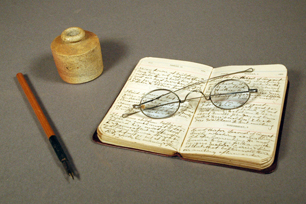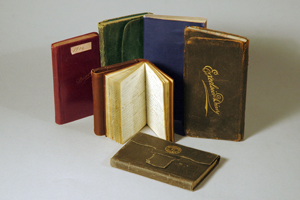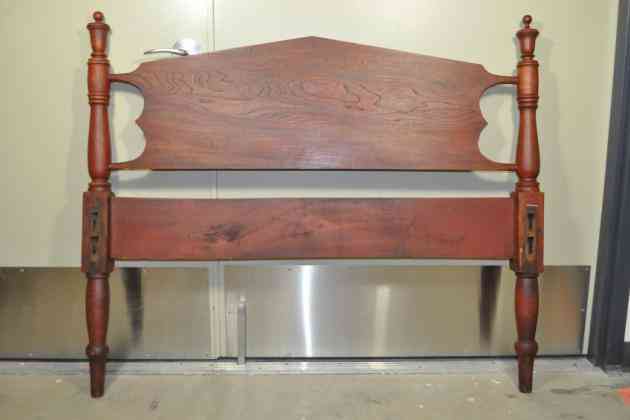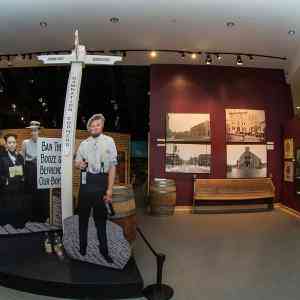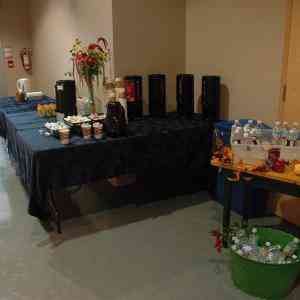
Mary Williams Trout: Diaries of a Small Town Lady
The compelling story of a small town lady, Mary Williams Trout (1847 – 1922) of Meaford, is told through 26 of her personal diaries (from the Grey County Archives Collection), spanning from 1867 to 1920. From her days as a school teacher, through her marriage and the First World War, these diaries are an excellent record of Mary’s life and a fine first-hand, primary-resource account of small town living from a woman’s perspective. Trout documents such topics as her religious life, her husband and children, local business, the talks and events she attends, when the train gets stuck, Christmas shopping, diphtheria deaths, what people do for recreation and amusement and how they travel.
Each diary has been digitized and transcribed, leaving the original handwriting intact while providing easy to read text. The diaries are also fully searchable for those looking for specific names, places, topics, or events. To view the text transcriptions download a diary, click on the "+" under the word "Layers," then click on the "eye-ball" icon next to the word "Handwriting."
Please note: diaries will download as a PDF document. In order to use the search function and view layers, they must be viewed using a PDF viewer such as Adobe Acrobat Reader DC.
Biography of a Small Town Lady
Mary Amanda Williams was born October 18, 1847 on a farm in St. Vincent Township, the eastern part of present-day Municipality of Meaford. Her parents, John Williams and Selina Williams (nee Brewster) were amongst the first settlers of this portion of the Queen's Bush, settling on lot 14, concession 9 in 1838, just three years after Charles Rankin had finished surveying the land. John Williams was the first Clerk and Treasurer of St. Vincent. Selina Williams was a direct descendant of William Brewster (1566 - 1644), a religious and spiritual leader for the Pilgrims who sailed on the Mayflower. With a politically active father and a long-standing family tradition of faith and religion, the foundation was laid for Mary's lifelong involvement in community and religious affairs.
On October 18, 1869, her 22nd birthday, Mary was married to James Trout (1839 - 1906). James was the son of William Trout, millwright and one of St. Vincent's first elected councilors, and Catherine Trout (nee MacKinnon). William Trout operated a sawmill on the Bighead river, south-west of Meaford, which employed the famous environmentalist John Muir from 1864 - 1866. The remains of this mill, which was destroyed by fire in 1867, can still be seen while hiking the Trout Hollow Trail, which runs from Meaford, along the Bighead river to the Riverside Community Centre. At this time, James helped out on the family farm during the summer months and worked as a salesman during the winter.
Mary was a school teacher at the time of her marriage, but had to relinquish her position as she was to focus her attention on housekeeping and farm work. James had purchased the back half of his family's farm with money he made as a salesman, and the home was well established when Mary moved in. In 1870, Mary gave birth to her first child, William Ernest, adding child care to her list of duties around the farm. In 1875, with the arrival of their second child, Kathleen, the couple moved to a larger house in Meaford, where James entered into business with his brother-in-law, Charles Jay. Until 1893, James and Charles were in the business of money-lending, insurance, and real estate. As money-lenders they gave financial assistance to many citizens of Meaford and surrounding area, contributing to the further development of farms, businesses, and factories.
Mary was very active in her community, regularly attending prayer meetings, business meetings, picnics and "socials." It was common for her to be out in the community visiting, shopping, or helping James with business. Most days she would eat at least one meal at a neighbour's house or serve an extra plate for a visitor. Often the people with whom she socialized were politicians and business men. She also taught music lessons and Sunday School classes. James and their son, Will, spoke often at prayer meetings, sometimes taking a leading role.
On February 7, 1879, disaster struck when Kathleen, James and Mary's only daughter, died of diphtheria at the age of four. The devastation of this event was longstanding, as Mary noted the anniversary every year. On February 7, 1920, Mary writes "Kathleen gone 41 years today." This would certainly not be the last time Mary dealt with death and loss. James had dealt with many serious health problems throughout his life, sometimes needing to travel long distances to find doctors and treatments to help. Though the circumstances were unfortunate, these trips allowed the Trouts to travel more than most people. Through these trips Mary and James spent time in Nebraska, Arkansas, and Florida. Although their time together was rich, James developed arteriosclerosis, causing hemorrhaging in his legs, eventually leading to his passing on February 16, 1906.
Mary remained as active in the community after James' death, and even took over some of his business dealings, collecting rent from tenants and overseeing the construction and maintenance of some new buildings. Her retirement years were spent much the same, with more time spent gardening, quilting, and helping friends, neighbours, and family. Mrs. Trout was well liked in her community and she had a positive effect on the lives of all she encountered. Sadly, on December 28, 1922, at 75 years of age, Mary passed away due to complications with her heart and kidneys. There is no doubt she was dearly missed by all who knew her.
This project was made possible in part through the Canadian Culture Online Program of Canadian Heritage, Library and Archives Canada and the Canadian Council of Archives. We are also appreciative of local sponsorship from the Grey County Historical Society.
Canadian Culture Online Program
References:
Archives of Ontario. Registrations of Deaths 1869-1934, MS935, Reel 125, 011416, 1906.
Archives of Ontario. Registrations of Deaths 1869-1934, MS935, Reel 288, 014084, 1922.
T. Arthur Davidson. A New History of the County of Grey: and the many communities within its boudaries and the city of Owen Sound, Grey County Historical Society, Owen Sound, Ontario, 1972.
Cherry Good. On the Trail of John Muir, Luath Press, Edinburgh, Scotland, 2000.
Stanley Knight Ed. Pictorial Meaford: a pictorial history of the town of Meaford 1818-1991, Stanley Knight Ltd., Meaford, Ontario, 1991.
E.L. Marsh, in cooperation with the Official Committee. A History of the County of Grey, 2nd Ed., Fleming Publishing Company, Ltd., Owen Sound, Ontario, 1999.
C.H. Pedlar. Selected Highlights from the History of Meaford and St. Vincent Township, C.H. Pedlar, 1991.
Peter M. Rinaldo. The Trouts from London: William Trout Branch, Dor Pete Press, Briarcliff Manor, N.Y., 1988.
St. Vincent Heritage Association. St. Vincent, A Beautiful Land: an illustrated township history, St. Vincent Heritage Association, Thornbury, Ontario, 2004.
Vina Rose Ufland Ed. History of the Schools of St. Vincent Township and Other Chronicles, 1847-1967, St. Vincent Council, St. Vincent, Ontario 1967.
< http://www.ontariotrails.on.ca/trails-a-z/trout-hollow-trail/ > (accessed May 19, 2009)
These reference materials are available for viewing at the Grey County Archives.
A Brief History of Meaford
In the summer of 1835, surveyor Charles Rankin reserved 200 acres on the southern shore of Georgian Bay at the mouth of the Big Head River for the town plot of Meaford. The first settler arrived from Ireland and built a log cabin on the south bank. In 1845 the town reserve was subdivided, and development stalled until 1850, but following that date, growth increased steadily.
The first train was welcomed into Meaford at 7:00 pm on November 14, 1872. In 1874 Meaford was incorporated as a town with a population of 1700 and Meaford’s first Council took office on Jan. 1 1875. By the early 1880s, Meaford was a thriving town with 3 planing mills, 3 carriage factories, 2 tanneries, a sawmill, a shingle mill, a woollen mill, 2 foundries, 1 machine shop, 4 cabinet stores, 2 flour mills, 2 printing offices, 12 general stores, 4 grocery stores, 2 jewellery stores, 2 stationary and fancy goods stores, 7 millinery and dressmaking shops, 1 fur store, 3 dry goods stores, 2 bakeries, 2 brickyards, 5 boot and shoe shops, 2 harness shops, 1 pump shop, 2 undertakers, 2 hardware stores, 2 blacksmith shops, 5 insurance and money brokers, 2 butcher shops, 3 lawyers, 4 doctors, 1 dentist and a resident photographer. In the second half of the nineteenth century there were 10 hotels servicing the needs of the community.
Meaford Public School was built in 1868: Upper Floor - Seniors; Lower Floor – Juniors. The average attendance in 1869 was 152 students. Meaford High School was built in 1890.
The first church in Meaford was built in 1856 for the Canada Presbyterians, not long after, the Disciples of Christ built a meeting house (Mary Trout’s religious affiliation). By 1865 there were churches established for the Church of England, Wesleyan Methodists, Episcopal Methodists, New Connexion Methodists and Congregationalists. In 1869 a Roman Catholic church was built. Other churches have come and gone. There has also been a Jewish presence in Meaford since the turn of the last century.
This project was made possible in part through the Canadian Culture Online Program of Canadian Heritage, Library and Archives Canada and the Canadian Council of Archives. We are also appreciative of local sponsorship from the Grey County Historical Society.
Canadian Culture Online Program
References:
Stanley Knight Ed. Pictorial Meaford: a pictorial history of the town of Meaford 1818-1991, Stanley Knight Ltd., Meaford, Ontario, 1991.
Vina Rose Ufland Ed. History of the Schools of St. Vincent Township and Other Chronicles, 1847-1967, St. Vincent Council, St. Vincent, Ontario, 1967.
These reference materials are available for viewing at the Grey County Archives.
Virtual Teacher's Tool - Mary Trout Diaries
The diaries of Mary Williams Trout contain information relevant to grades 2, 3, 7, and 8. This tool is intended as a time-saver for teachers, including opportunities for Integrated Studies, with suggestions for projects, activities, and class discussions, using the content of the diaries as a jumping off point to a broader theme or topic in Canadian society. The project suggestions are designed to require further research on the part of the student to encourage students to use a variety of resources. The curriculum points included in this guide are referenced from curriculum documents available at the Ontario Ministry of Education website.
The curriculum streams covered in this tool are:
Grade 2: Heritage and Citizenship - Traditions and Celebrations
Grade 2: Science and Technology - Properties of Liquids and Solids
Grade 2: Science and Technology - Air and Water in the Environment
Grade 3: Science and Technology - Growth and Changes in Plant
Grade 3: Science and Technology - Soils in the Environment
Grade 3: Canada and World Connections - Urban and Rural Communities
Grade 7: Science and Technology - Interactions in the Environment
Grade 7: Geography - Natural Resources
Grade 8: History - Canada: A Changing Society
- Diary 1 (6 MB)
- Diary 2 (10 MB)
- Diary 3 (10 MB)
- Diary 4 (11 MB)
- Diary 5 (12 MB)
- Diary 6 (13 MB)
- Diary 7 (10 MB)
- Diary 8 (10 MB)
- Diary 9 (9 MB)
- Diary 10 (9 MB)
- Diary 11 (8 MB)
- Diary 12 (8 MB)
- Diary 13 (9 MB)
- Diary 14 (10 MB)
- Diary 15 (10 MB)
- Diary 16 (11 MB)
- Diary 17 (10 MB)
- Diary 18 (10 MB)
- Diary 19 (10 MB)
- Diary 20 (10 MB)
- Diary 21 (10 MB)
- Diary 22 (10 MB)
- Diary 23 (9 MB)
- Diary 24 (10 MB)
- Diary 25 (10 MB)
- Diary 26 (12 MB)

